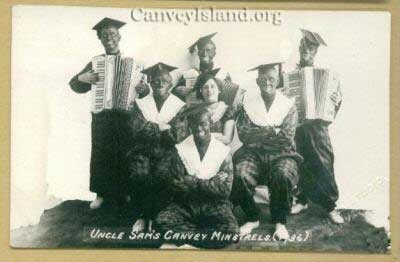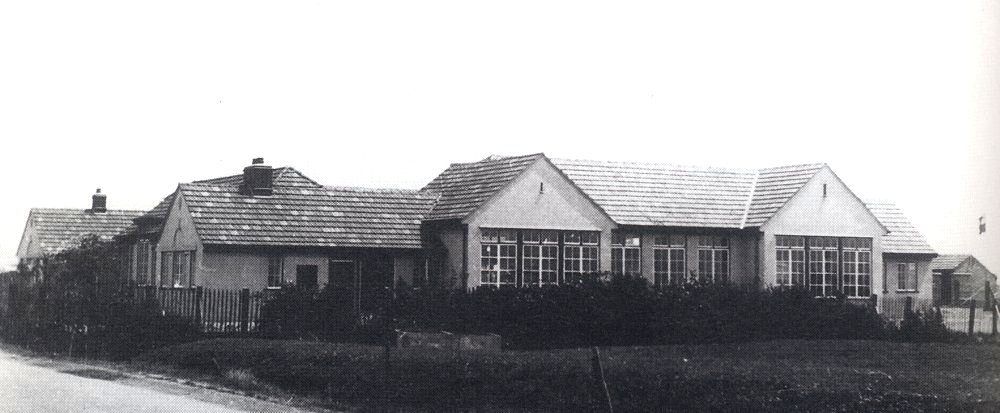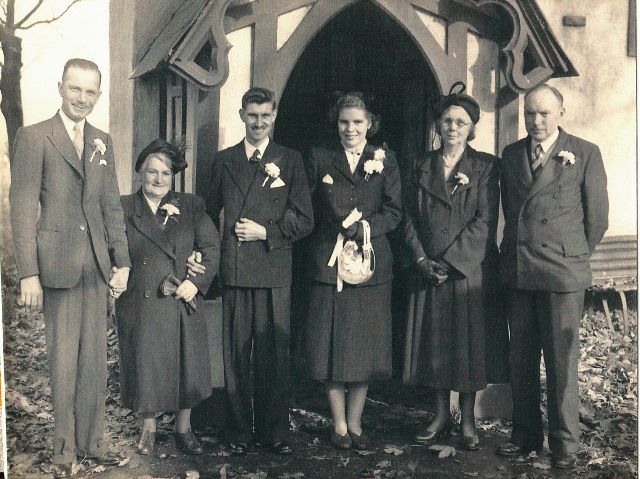I came to Canvey when I was a nipper at 9 months old. My family rented a bungalow at the bottom of Eldertree Road. A footpath at the side leads through to Waalwyck Drive. The bungalow was called ‘The Herme’. It was owned by a Mrs Baker. She had several properties and caravans that she had as summer lets. You had to go and fetch the water from Cook’s farm. You could not miss it as it had Cook’s Dairy printed in big white letters on the roof. Canvey at that time was mostly undeveloped farmland. The dairy was in what is now Farm Road halfway along Harvest Road. Central Wall Road was an old seawall with about a 2 foot 6 inch wide concrete path which replaced a wooden slatted walk known as duck boards.
I was about 5 or 6 years old when my father bought a piece of land in the Newlands area in Mornington Road near where the little roundabout is now by the old sea wall. My Dad went to Fielder and asked him to build a bungalow for him. Fielder said ‘No, don’t bother doing it like that. Why not buy one of mine already built and I’ll take your plot as a deposit’. So that’s what he did and moved into 1 Mayland Avenue probably in 1936. The Island at that time didn’t have much of a main drainage system. So it only had a chemical closet locally known as ‘bucket and chuck it’. The house finally had main drainage in 1936/37. My father sadly passed away in July 1950 and my mother in 1952. Both are interred at St Katherine’s churchyard. St Katherine’s is now the Heritage Centre. After my mother died the house had to go to probate and I went to live with my sister Kathleen in Waalwyck Drive. My family was a London one and 1 Mayland was our holiday home and we spent every school summer holiday there until our London home was bombed out in 1942. So I and my family came to live on Canvey permanently at that time.
In 1947 Harry William’s son was killed in a sailing accident. The two men who were employed by Harry had just left to set up business on their own. Without his son either this left him with no one to help him in his building business. I used to work for Harry and so he asked me to work for him again. So I left the Merchant Navy and because I didn’t re-join a ship after 3 months I was then eligible to be conscripted into the Army. I went on basic training in Oswestry and then did duty in the canal zone in Egypt and then 6 months in Akkabar in Jordan. I came home in 1951 in time for the Festival of Britain.
I joined the Merchant Navy when I was about 15/16. I first went on an 8 week course at Portsmouth. My first ship was the ‘Thrilby’ owned by Robbie Robner from Darlington. It transported grain to the River Plate via Las Palmas to take on fuel and water etc.
My first job when I left school at 14 was working for Harry White on his farm called Sluice Farm which was situated by the pumping station. Next to that was his cow shed, then the house with the rick yard.

In the back garden of ‘Dolce Domum’ in Village Drive
I lived with my sister until I married in 1954 in St James the Less in Hadleigh because my wife was a Hadleigh girl. When she was expecting our first child we moved to Paarl Road and then to ‘Dolce Domum’ in the Village where we lived for 2 to 3 years. The bungalow belonged to Archie Tibbett, who owned half the Village. The photo was taken in the back garden of the bungalow. Apart from me on the left sporting a moustache there’s also my brother in law who emigrated to New Zealand and then moved to Australia. I was now working for Loe and Co.
Slideshow based comments
Referring to the Archive slide show, one of the photos shown was of a houseboat moored in Benfleet Creek at the beginning of Ferry Road where the buses used to turn round. It was Ronnie and Ray Lucksford’s in the late 50’s early 60’s. They had a young daughter. My sister-in-law was friends with the young couple and stayed with them a few times.
 Referring to CCA postcard of Labworth Café. In the distance in the top left hand corner is a building which housed Uncle Sam’s N….. Minstrels where they used to put on two shows a day. The building itself was a long, low one, timber-framed in about 6 foot sections. The top part was of heavy canvas which was pulled up when the shows were on and let down afterwards, presumably for ventilation. It was located behind the café about where the putting green used to be. The minstrels used to wear a one piece costume of bright orange and black diamonds which were about 3 inches in size, similar to Andy Pandy’s. Also they had school mortar board hats and used to black their faces. Their shows were popular in the 20’s and 30’s. The Labworth Café itself was designed by the same architect who designed the Sydney Opera House in Australia. The café when viewed from the river is meant to look like the bridge of a ship.
Referring to CCA postcard of Labworth Café. In the distance in the top left hand corner is a building which housed Uncle Sam’s N….. Minstrels where they used to put on two shows a day. The building itself was a long, low one, timber-framed in about 6 foot sections. The top part was of heavy canvas which was pulled up when the shows were on and let down afterwards, presumably for ventilation. It was located behind the café about where the putting green used to be. The minstrels used to wear a one piece costume of bright orange and black diamonds which were about 3 inches in size, similar to Andy Pandy’s. Also they had school mortar board hats and used to black their faces. Their shows were popular in the 20’s and 30’s. The Labworth Café itself was designed by the same architect who designed the Sydney Opera House in Australia. The café when viewed from the river is meant to look like the bridge of a ship.
The Casino. I used to dance there. The couple who owned it used to run a Sunday dance club with an open dance at the weekend. The owners lived in Fairlop Avenue. Referring to the slide show pictures of the fair – it was a travelling fair. There was another one at May Avenue called Andrew’s. Further along the seafront was the Peerless Pavilion which was where the Windjammer pub now is.

Bay Country Club
Another slide showed the Bay Country Club and in the distance on the right hand side is a 2 storey building. This was the Café Rose. Beside it on the left hand side was a large caravan in which they used to store camping equipment that was hired out in the season. It was situated roughly on the corner of Sylvan Close and Cleveland Road. The Bay Country Club was situated in Western Esplanade about opposite to where the entrance to the car park and Welcome Hut café now is. The proprietor was a Mrs Carey prior to which she was the licensee of the Red Cow in the Village (more of the Red Cow later). The Bay Country Club had a fairly large ballroom with a nice sprung dance floor. It was also used for roller skating. In the mid to late 40’s the Bay Country Club was my Dad’s favourite watering hole. The Bay Club has had several names during its lifetime. One was the Water’s Edge another and the most famous was during the disco era of the 70’s when it was called the Goldmine with an upstairs bar called Two Flights Up. The Goldmine became famous after the DJ started playing Glenn Miller type records and it really took off. People came from far and wide to be seen there. So much so that the BBC’s Blue Peter program spent a whole day filming there and featured it on their program.
The War Memorial used to be outside Tremain’s on the corner of Craven and Long Road. It was later re-located to the grounds in front of the Paddocks.
I was on Canvey when World War 2 was declared. My family heard it on the 6 o’clock news on a Cosser radio that had been bought from Mr Shoffren who owned Tower Radio in the High Street on the corner of Larup Avenue. In those days it was a 2–storey building with about 4 or 5 steps leading up to the shop.
My family hurriedly returned to London only for me and my brother to be evacuated the following day to Witham. We might just as well have stayed on Canvey.

William Read School
I attended the William Read School in Long Road. At that time it was a square one-storey building with classrooms forming the outer walls and with a garden in the middle. The boys’ playground was on the right hand side and the girls’ on the left. It had a row of outside toilets. When the Island was sparsely populated the school was at St. Katherine’s Church Hall. As the population increased the William Read School was built. At that time most of the drainage dykes had not been piped and filled in. You had to cross a dyke that ran at the side of Long Road entrance to the girls’ playground side. The first room was the headmaster’s room, the next was Mr. Phillip’s classroom and the next was Miss Wiggs. The first room on the Long Road side was the music room. The opposite classroom on the right hand to Mr. Phillips was a teacher known to the pupils as Slasher Eales. Although he was a lay preacher he was not averse to using the cane, hence the nickname of Slasher.
There used to be a rather deep dyke, since piped, that ran from the Lake the length of Denham Road at the back of the houses between North Avenue/East Crescent. It crossed Long Road and continued at the back of the gardens on the right hand side of Craven Avenue and the school playing field and through to the holiday camp. Another shallower one ran between Hertford Road and Hayes Road and crossed Southwick Road and on between the other part of Hertford Road and Southwick Gardens, on through the school grounds and joined the one in Craven Avenue. As it passed the girls’ playground there was a wooden bridge over it which led to what was the Junior School. This was a wooden building painted a cream colour. As there were so few pupils there was only one teacher. She was a Welsh lady who lived in a house called ‘Ty Gwen’. I think that’s how it was spelt. The translation of it meant ‘White House’. There was also a path from the school into Craven Avenue. Long Road Junior School near Hawkesbury Road was opened in 1937. This school’s first headmaster was a Mr. Benson. He used to come to school in a red, two-seater sports car. One day a mischievous schoolboy pushed a potato up the exhaust pipe. It was several weeks before he could come to school in it again. I must add that I was not the boy with the potato!

Leslie Perry’s wedding at St Katherine’s
One of the few times I went to church was for my brother’s wedding in St Katherine’s in November 1951. See photo above. Key: left to right – bro in law Leslie, mother Mary, brother John, sister-in-law Eileen, parents of bride.
The lychgate at St Katherine’s was donated by Colonel Fielder in memory of his mother.
My first job after leaving school at 14 was for Harry White on his farm called Sluice Farm. Later I worked for a Benfleet builder who was also an undertaker called Harry Williams. His painter/decorators doubled as pall bearers. Harry William’s sister Mabel ran the Orange Café. She had a daughter. When she gave up the café she ran the Premium Stores which was in the High Street half way between Mitchell’s Ave and Smallgain’s corner. Now all redeveloped. She sold all sorts of things in the shop. Harry’s brother had a snooker club in Folksville Rd. He had 7 children. He started an estate agents. The oldest son carried on the estate agent’s business but in Wickford. About 10 years ago there was an article featuring him looking for Canvey memories. He had a website.
I moved to my present house in the Village in 1961.There are now only 3 people in my road who are original residents. After the Village pump was removed in 1937 there used to be a metal plaque in the road to show where it used to be. It’s been removed and can now be found at the Dutch Cottage along with the horse trough that stood beside it.
Behind the old church is the estate built by Charles Hollingberry and he used the old Charfleet’s Farm barn for storage. The barn was immediately behind where the garage now is. There was another barn where the car showroom on the corner of Chhrfleets Road now stands. I think it was owned by Theobalds.

Loe & Co
I worked for Loe and Co who built the Paddocks and also the Waterside Farm Sports Complex. The latter was built quickly before the councils of Canvey and Benfleet were merged into Castle Point. The Complex was finished in 1975. I stopped working for Loe and Co. in 1979 because of back trouble.
In 1956 the plans for the new St Nicholas Church were sent to Loe and Co for them to build but they weren’t interested. Instead it went to a firm on the Manor Trading Estate in Benfleet which was a specialist in building using prefab concrete beams.
The farms.
Re. Brickhouse Farm at the bottom of Deepwater Road. There are only barns there now, no farmhouse any more. In the road that led down to it there were cottages which were called Chase Cottages. The end cottage was lived in by the Ware family who owned a glass business. Alan and daughter Marion sold up and moved to Rhodesia. They took their grandfather too. He used to work for the Southend Water Co. People used to have a key to use the standpipes. The granddad used to work for a builder and helped connect people to the mains water supply.
Scar House Farm disappeared because it was bombed. I think it belonged to Wally Brown who also had a café which would have been next door to where the florist’s now is. When I was working on the estate that Loe and Co were building in the Village I used to go to the café on Monday and ask for toast and dripping – the latter probably from Brown’s Sunday roast.
Me and my mate used to go to the big duck pond and Scar House Farm and use a massive barn door as a raft. There used to be quite a few farms. Tree House was to be found right at the end of Northwick Road.
Waterside Farm was Leach’s and the 4 cottages are where his stock men lived. Russellhead was where his shepherd lived. There was another small farmhouse near the Dutch Cottage but it was demolished when the oil company was going to build on the Island. All that was left of it for many years was an Anderson shelter on which the slogan ‘Go to hell URL’ was painted. Leach kept pigs there.




Comments about this page
The Welsh lady’s house name would have been spelt Ty Gwyn. ( = White House), pronounced “Tee Gwinn”.
I don’t speak Welsh, but when I was a student in Cardiff, my Hall of Residence was in Ty Gwyn Road, and a fellow Welsh-speaking student explained what this and other Welsh words meant, and how to pronounce Welsh words correctly .
I remember the Cafe Rose from a 1950’s Sunday School outing. We ate our packed lunches in a field next to the cafe, and I think our church had arranged for the cafe to prepare them for us.
Add a comment about this page